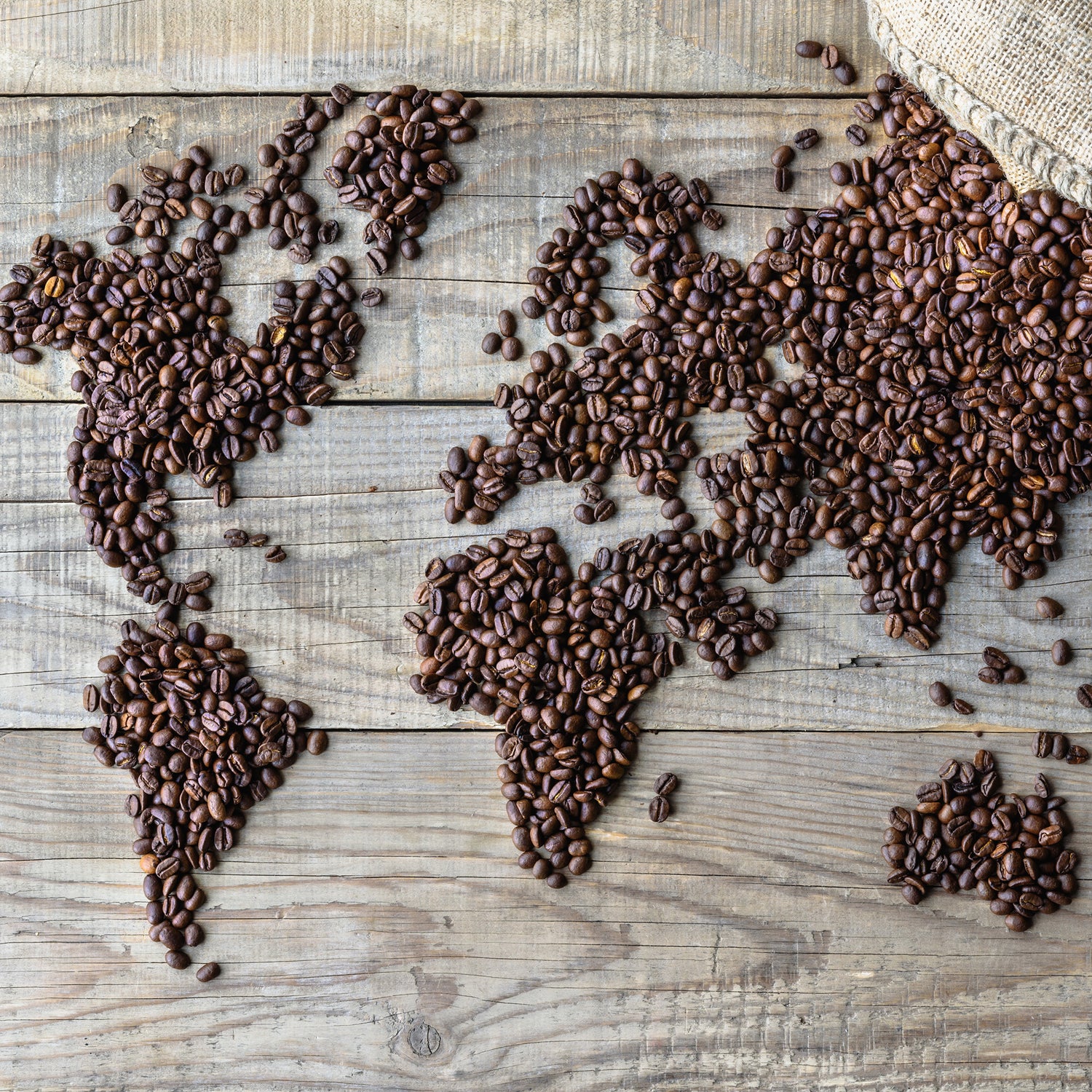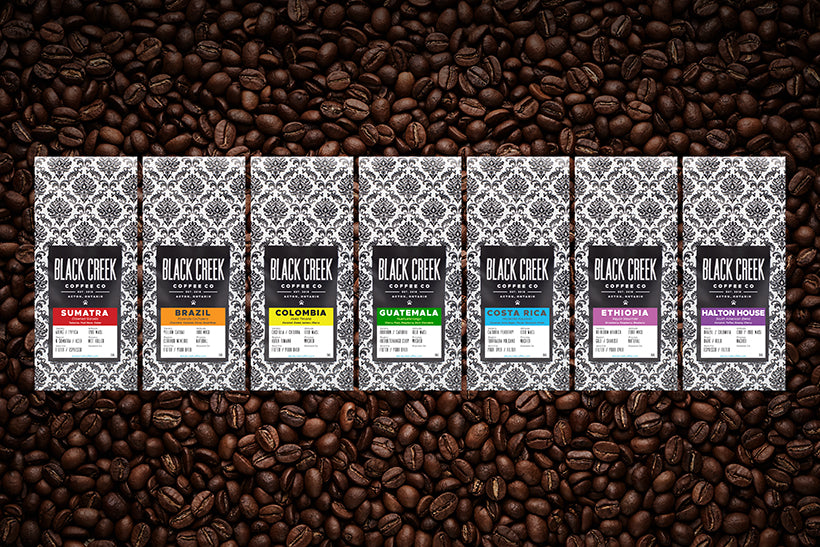The different flavours of coffee
There are many different elements that determine the flavour and aroma of fresh coffee. Here we'll give you a brief summary of what those are, and how to choose one of our coffees to suit your particular tastes.
These are the main factors that affect the taste of coffee
- Variety
- Country of Origin & Terroir
- Farming
- Processing
- Blending
- Roasting
- Other
Variety
Coffee varieties are derived through selective breeding of plants or natural selection. There are around 40-50 current commercial varieties, bred by farmers to yield coffee plants with better disease resistance, and higher cup quality. These are split into two main species, Arabica and Robusta.
Arabica tends to have a smoother, sweeter taste, with flavour notes of chocolate and sugar, but is harder to grow and more susceptible to coffee leaf rust, a disease which can decimate crops. Currently all of our coffees are Arabica due to the higher cup quality.
Country of Origin & Terroir
Coffee is grown in a centralized 'coffee belt' area around the equatorial regions of the world, shown below. The top four coffee producing countries are Brazil, Vietnam, Colombia, and Indonesia.

These countries grow coffee plants at various altitudes, soil types and climates, which greatly affect the final taste. If you've ever been to a wine tasting and tried different wines of the same grape, from different elevations, then you'll know what we mean.
Terroir is a French wine-making term that describes how the collective profile of the growing environment affects the taste of the final product, so altitude, climate, soil, temperature, humidity and so on. These factors are the reason that it is easier to produce exceptional coffee in some countries than others. Countries with high elevations such as Costa Rica, Colombia, and Ethiopia, can produce excellent coffees easier than say Brazil, which generally produces more affordable beans.
Other environmental factors also help produce wonderful coffees. Volcanic soil is rich in nutrients, distinct wet and dry seasons help with harvesting and can determine processing methods, and higher altitudes produce more complex, dense flavours. This is why single origin coffees are so flavourful and interesting, and also make the basis for great blends too.
Farming

Coffee plantations range from single smallholder farms, to family estates, to larger plantations that have been around for over 100 years. The best coffee farmers will have the goal of producing the highest quality coffee within the constraints of their terrior (above) and helping the local economy. This may include working with other producers in a cooperative, ensuring coffee plants are planted in an eco-friendly way such as growing them in the shade of other trees, and also ensuring that coffee is produced to certain certifications such as Rain Forest Alliance, Fair Trade, or Organic.
There is also the picking method to consider. Hand picked coffee cherries are likely to be more ripe, which results in sweeter, more complex flavours. More mechanized picking methods are more efficient for larger farms, but also result in lower overall quality and consistency, as unripe cherries can add unpleasant flavours to the cup. This is partly why specialty coffee costs more to produce than commodity coffees.
By focusing on all of these quality measures, coffee farmers can conserve ecosystems, protect biodiversity and waterways, reduce agrochemical use, and safeguard the well-being of workers and local communities.
Processing

Coffee beans are the seeds of the coffee cherry, and need to be removed from the fruit and 'processed' before being dried and stored, ready for export. There are several layers of skin, fruit flesh (mucilage), and parchment on a coffee bean, and the various ways of removing these can give coffee very different flavours.
Natural
With Natural or 'Dry Processed' coffees, the beans are dried with all of the fruit still attached. This results in a sweet, fruity taste, with low acidity. In Ethiopia this is done on raised beds, and takes around 10-15 days. Our Kayon Mountain is a great example of a Natural processed coffee, with amazingly bright fruit notes.
Washed
Washed or 'Wet Processed' coffees have all of the fruit flesh (mucilage) removed using water. Usually the cherries are pulped, and then fermented in tanks for up to 24 hours to help break down the remaining fruit. After fermentation the beans are washed to remove any remaining mucilage, and then laid out on beds to dry, either in the sun or in a dryer.
Washed coffee tends to have a very clean taste, with higher acidity, and more chocolate and caramel flavours, vs fruit with natural processing. With a washed coffee, you are focused on tasting the bean variety, the terroir, and not the processing method.
Our Costa Rican Grand Peaberry is a great example of a clean, classic, washed coffee.
Honey
Honey processed coffee is somewhere in the middle of Natural (Dry Processed) and Washed (Wet Processed). The outer skin is removed, but some of the sticky, sweet cherry flesh is left on the bean to dry. There are various grades of honey processing:
- White Honey - tend to be mechanically washed, with the minimum amount of cherry left on the bean
- Yellow Honey - semi-washed, leaving more mucilage and therefore a sweeter taste
- Red Honey- more mucilage left on and longer drying times lead to more fruity flavours and sweetness
- Black Honey - laborious and expensive to produce, but leaving the most cherry flesh on the bean, which gives a very sweet tasting coffee
Our Costa Rican Finca El Mango is a wonderful example of a Black Honey processed coffee.
Blending

As you can see, coffees from many different origins can have significantly different flavours. Whilst single origins are very popular, allowing that farm-to-cup tasting experience, developing unique blends is also a way of creating exciting new flavours and consistency across harvest periods.
For example, some Brazilian coffees are the perfect base for espresso based drinks, with low acidity, good body, and consistent cocoa notes. But they can also be a bit neutral or bland on their own. With our Sanctuary Espresso we added both Colombian and Ethiopian beans to the Brazilian based blend, to add even more toffee notes, and also the creaminess of the Ethiopian Yirgacheffe.
Roasting

Each of these topics easily deserves a full blog post, none more so than the roasting process itself. As a coffee roastery, we at Black Creek Coffee import the green coffee beans from all around the world, and roast them to perfection at our roastery in Acton, Ontario. Each bean or blend has a specific roast profile to ensure proper inner-bean development, and to highlight the best characteristics of that particular coffee.
As you apply more heat and longer roasting times, acidity starts to reduce, and body increases. We'll write a more detailed article on this in future, but for simplicity we'll group our roast profiles into:
- Very Light - Roasted to 380F - 390F, very acidic, with grassy, peanutty flavours
- Light - Roasted to 390F - 410F, dropped soon after first crack (when the beans begin to 'pop' and release steam and carbon dioxide), high acidity, light body, lots of fruit and floral flavours
- Medium - Roasted to 410F - 430F, a pleasing balance of moderate acidity, mellow caramels, and medium body
- Medium/Dark - Roasted to 430F-445F, dropped around second crack, caramelly, nutty, heavy body, with oils beginning to show
- Dark - Roasted to 445F+, bold smoky taste, more oily with less of the origins coming through
- Very Dark - French/Italian Roast - not us.
We want our customers to be able to fully appreciate the flavours imparted from each origin or blend of beans, and therefore don't produce any bitter and burnt dark roasts.
Other Factors
Other things to take into account that will affect the quality of your coffee are:
- Freshness: Ideally you should be consuming your coffee within 4-8 weeks of it being roasted, although it will stay fresh a little longer if unopened. This is the main benefit of buying from a small batch roaster such as Black Creek. Coffee from larger brands could have been roasted anywhere from 6-12 months ago and has been losing freshness ever since.
- Grind Quality: The consistency of your grind is as important as the quality of beans you buy. Many a good coffee has been ruined by either the wrong grind type (too coarse or too fine) or poor consistency (different sized grounds). Invest in a good quality burr grinder to ensure a quality cup every time.
- Brewing Method: Brewing methods can change depending on taste, location, and equipment available. Brew ratios, grind sizes, water type and temperature, all can have an impact on cup quality. Luckily there is equipment for every eventuality, like an AeroPress for espresso on the go.
- Storage: Ideally, coffee should be stored as whole bean, in an airtight, preferably vacuum container. For maximum freshness, only grind your coffee when you are about to brew it.
Our Coffees
Here is a chart showing the various coffees that we currently roast and how to compare the different flavour and roast profiles. Feel free to reach out to us using our contact page if you need any help in selecting a coffee, or try our sample pack to taste a selection from around the world. We hope you've enjoyed this guide!






5 comments
Have ordered before . Would like to enquire about a monthly delivery subscription with a different blend of whole beans a month paid on a yearly basis. Will you please let me know price ,with shipping, for a year , – 12 different bean varieties all costs in .To Georgetown ,Ont. Any suggestions you have are much appreciated
I received a bag of your Columbian as a Christmas gift. I’ve already finished it so today I placed my first order. Excited to try the Costa Rica Finca El Mango!
Going to place my first order to try your Coffee hope to make it mine!
Yes that would be correct.
Can you tell me what the two Boldest Coffee’s you have are. If I read the chart correct it would be the Halton House Preimum Blend and the Sumatra Crowned Garuda.